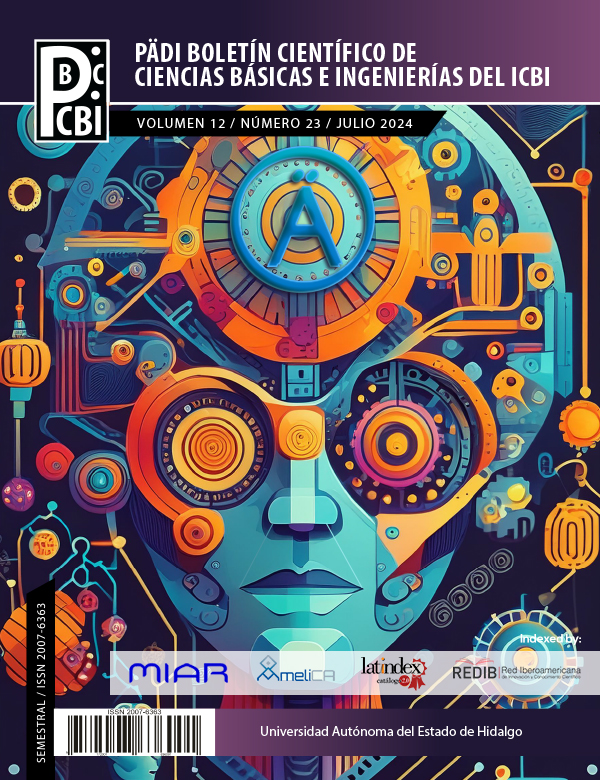Utilization of mining waste in permeable concrete as an alternative of sustainable construction
Abstract
In Pachuca de Soto, Hidalgo, the accumulation of millions of cubic meters of waste from mining activity for more than 500 years has been recorded. These wastes, known as “tailings,” have no use or social benefit. Although its chemical composition does not show potentially toxic elements in representative quantities, it affects the population's health because the particles can be easily transported by water and air. The proposal to reuse tailings in the construction of permeable concrete is an efficient alternative to reduce the environmental impact, being efficient as a substitute for cementitious in a low proportion. Likewise, its use does not require any additional process. In this study, permeable concrete was produced with mining waste as a substitute for hydraulic binder in dosages of 0, 5, 10, and 15%. The results showed that up to a dosage of 10%, the specimens had a behavior similar to conventional permeable concrete.
Downloads
References
ASTM. (2005). 39/C 39M Standard Test Method for Compressive Strength of Cylindrical Concrete Specimens. Annual book of ASTM standards, 4.
Arrieta, R. F., & Carro, A. N. (2011). Diseño de mezclas para evaluar su resistencia a la compresión uniaxial y su permeabilidad. Infraestructura vial, (24), 40-49.
Ayala-López, J. E., Gil-Ahumada, E., Cornejo-Ramos, R. D., & Muñoz-Pérez, S. P. (2022). Metodologías empleadas para la producción de concreto permeable usando parcialmente materiales reciclados como agregados: una revisión literaria. TecnoLógicas, 25(53).
Bravo Callao, I. L. (2021). Evaluación de las propiedades físicas del concreto poroso para pavimento rígido elaborado con aditivo en Jaén.
Cruz-Palafox, C., Segovia-López, A., González-Sandoval, M., Lizárraga-Mendiola , L., Olguín-Coca, F. J., y Rangel-Martínez, Y. (2014). Diseño de un concreto permeable para la recuperación de agua. UAEH. Recuperado de https://www.uaeh.edu.mx/investigacion/productos/6287/diseno_de_un_concreto_permeable_para_la_recuperacion_de_agua.pdf
Drake, J. A., Bradford, A., y Marsalek, J. (2013). Review of environmental performance of permeable pavement systems: State of the knowledge. Water Quality Research Journal of Canada, 48(3), 203-222.
Enshassi, A., Kochendoerfer, B., & Rizq, E. (2014). Evaluación de los impactos medioambientales de los proyectos de construcción. Revista Ingeniería de construcción, 29(3), 234-254.
Fassman, E. A., y Blackbourn, S. (2010). Urban runoff mitigation by a permeable pavement system over impermeable soil. Journal of hydrologic engineering, 15(6), 475-485.
Flores Prieto, J. R. (2010). Caracterización del concreto permeable usando el módulo de ruptura y el porcentaje de desgaste.
Hernández, E., Mondragón, E., Acevedo, D., y Robledo, E. (2009). Vegetation, mining tailings and potentially toxic elements of a jal from Pachuca, Hidalgo, México.
Hidrocreto (2018). Sistema para infiltrar o recuperar el agua pluvial por medio de pisos y pavimentos porosos. Recuperado de: https://docplayer.es/60017949-Concreto-permeable-ecologico-ecocreto-hidrocreto.html
Jiménez Pesantes, H. J. (2019). Evaluación del concreto permeable como una alternativa sostenible para el control de las aguas pluviales en la ciudad de Castilla, provincia Piura y departamento de Piura.
Maynard. D. P. (1970). "A no-fines road." Concrete Construction. 15(3). 116- 117.
Moss, J. K. (1979). No-fines building gives energy-conserving homes. International Construction, Surrey.
Oggu, A., & Madupu, L. S. (2022). Study on properties of porous concrete incorporating aloevera and marble waste powder as a partial cement replacement. Materials Today: Proceedings, 52, 1946-1951.
Ortega-Villar, R., Lizárraga-Mendiola, L., Coronel-Olivares, C., López-León, L. D., Bigurra-Alzati, C. A., y Vázquez-Rodríguez, G. A. (2019). Effect of photocatalytic Fe2O3 nanoparticles on urban runoff pollutant removal by permeable concrete. Journal of environmental management, 242, 487-495.
Patiño, O. (2013). El concreto permeable: uso y estándares. Mente & Materia, 4(1), 22-23.
Pérez Ramos, D. (2009). Estudio experimental de concretos permeables con agregados andesíticos.
Puertas, F., Alonso, M. M., y Palacios, M. (2020). Construcción sostenible. El papel de los materiales.
Senado de la República (2021). El 50 por ciento de las emisiones contaminantes pertenecen al sector de la construcción. Coordinación de Comunicación Social, Senado de La República. Obtenido de https://comunicacion.senado.gob.mx/index.php/informacion/boletines/50135-el-50-por-ciento-de-las-emisiones-contaminantes-pertenecen-al-sector-de-la-construccion.html
Solano-Cerdas, C. (2009). Análisis de la flexo tracción del concreto permeable
Suriya, S., y Mudgal, B. V. (2012). Impact of urbanization on flooding: The Thirusoolam sub watershed–A case study. Journal of hydrology, 412, 210-219.
Tan, Y., He, Y., Cui, X., y Liu, L. (2022). Design and performance optimization of alkali-activated waste coal bottom ash/slag porous concrete. Construction and Building Materials, 359, 129413.
Teymouri, E., Mousavi, S. F., Karami, H., Farzin, S., y Kheirabad, M. H. (2020). Municipal Wastewater pretreatment using porous concrete containing fine-grained mineral adsorbents. Journal of Water Process Engineering, 36, 101346.
Volpi León, V. (2017). Efecto de corrosión en concreto reforzado elaborado con desecho minero (jal) (Master's thesis, Benemérita Universidad Autónoma de Puebla).
Copyright (c) 2023 Alejandro González-de-la-Fuente, Luis Daimir López-León, Valeria Volpi-León, Yasbeth Paola Correa-Castro, Liliana Lizárraga-Mendiola, Iván Erick Castañeda-Robles

This work is licensed under a Creative Commons Attribution-NonCommercial-NoDerivatives 4.0 International License.













